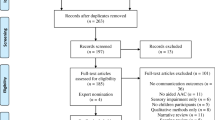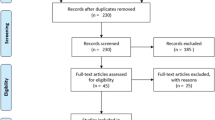Abstract
Purpose of Review
Neurodevelopmental disorders lead, many times, to serious communication problems that also affect their quality of life. Therefore, it is essential to undertake rehabilitation projects aimed at promoting communication through the use of alternative and augmentative communication strategies and tools. The main objective of this systematic review based on existing scientific literature is to analyze the different types of rehabilitation systems and/or programs based on the use of AAC: technology-free, low-tech, and high-tech.
Recent Findings
The results indicate clear levels of effectiveness in relation to medium- and high-tech SGD devices for mediating AAC interventions oriented towards the development of communication and language skills.
Summary
Alternative and augmentative communication (AAC) makes it possible to improve a person’s communication skills starting from minimal behaviors that are already present in the individual repertoire.
Similar content being viewed by others
Data Availability
Data were available without any restriction upon request to the corresponding author.
References
Papers of particular interest, published recently, have been highlighted as: • Of importance •• Of major importance
Ganz JB, Earles-Vollrath TL, Mason RA, Rispoli MJ, Heath AK, Parker RI. An aggregate study of single case research involving aided AAC: participant characteristics of individuals with autism spectrum disorders. Res Autism Spectr Disord. 2011;5:1500–9.
Meinzen-Derr J, Sheldon RM, Henry S, Grether SM, Smith LE, Mays L, et al. Enhancing language in children who are deaf/hard-of-hearing using augmentative and alternative communication technology strategies. Int J Pediatr Otorhinolaryngol. 2019;125:23–31.
Light J, McNaughton D, Caron J. New and emerging AAC technology supports for children with complex communication needs and their communication partners: state of the science and future research directions. Augment AlternCommun. 2019. The results of this study suggest that AAC technologies make it possible to improve language learning, facilitate social interaction, improve literacy skills, increase participation in society, and teach interaction strategies to communicative partners.
Light J, McNaughton D. From basic to applied research to improve outcomes for individuals who require augmentative and alternative communication: potential contributions of eye tracking research methods. Augment Altern Commun. 2014;30:99–105.
Wilkinson KM, Hennig S. The state of research and practice in augmentative and alternative communication for children with developmental/intellectual disabilities. Ment Retard Dev Disabil Res Rev. 2007;13(1):58–69.
Petrilli R, L’interazione simbolica, introduzione allo studio della comunicazione, Perugia, Guerra Edizioni; 2002.
Stasolla F, Picucci A, Caffò AO, Signorile C, Stortolo L, Mazzarelli A, Signorile M, Lancioni G. Assistive technologies for promoting inclusion for children with multiple disabilities. Tecnologie didattiche. n.d.;28(3):178–184.
Angermeier K, Schlosser RW, Luiselli JK, Harrington C, Carter B. Effects of iconicity on requesting with the picture exchange communication system in children with autism spectrum disorder. Res Autism Spectr Disord. 2008;2:430–46.
Charlop-Christy MH, Carpenter ML, LeBlanc LA, Kellet K. Using the picture exchange communication system (PECS) with children with autism: assessment of PECS acquisition, speech, social-communication behavior, and problem behavior. J Appl Behav Anal. 2013;35:213–31.
Chen SK, Hill K, Kay S, Ridenour T. Feasibility study of short-term, intensive augmentative and alternative communication intervention with Mandarin Chinese speaking children with autism. J Speech Lang Teach Ther. 2015;19:135–51.
Frea WD, Arnold CL, Vittimberga GL. A demonstration of the effects of augmentative communication on the extreme aggressive behavior of a child with autism within an integrated preschool setting. J Posit Behav Interv. 2011;3:194–8.
Ganz JB, Simpson RL, Corbin-Newsome J. The impact of the picture exchange communication system on requesting and speech development in preschoolers with autism spectrum disorders and similar characteristics. Res Autism Spectr Disord. 2008;2:157–69.
Marckel JM, Need NA, Ferreri SJ. A preliminary analysis of teaching improvisation with the picture exchange communication system to children with autism. J Appl Behav Anal. 2006;39:109–15.
Muharib C, Correa V, Wood C, Haughney K. Effects of functional communication training using GoTalk Now TM iPad application on challenging behavior of children with ASD. J Spec Educ Technol. 2018;34(2).
Olive ML, Cruz B, Davis TN, Chan JM, Lang RB, O’Reilly MF. The effects of enhanced milieu teaching and a voice output communication aid on the requesting of three children with autism. J Autism Dev Disord. 2007;37:1505–13.
Oliva M, Lang R, Davis T. An analysis of the effects of functional communication and a voice output communication aid for a child with autism spectrum disorder. Res Autism Spectr Disord. 2022;2(2):223–36.
Sigafoos J, Drasgow E, Halle JW, O’Reilly M, Seely-York S, Edrisinha C. Teaching VOCA use as a communicative repair strategy. J Autism Dev Disord. 2004;34:411–22.
Waddington H, Carnett A, Van deer Meer L, & Sigafoos J. Teaching two autistic children to request continuation of social routines with their parents using an IPad-based speech-generating devices. Adv Neurodevelopmental Disord. 2021.
Duchan JF. Autism spectrum disorders and AAC. J Autism Dev Disord. 2009;39(12):1755–6.
Boesch M, Da Fonte MA. Effective augmentative and alternative communication practices: A handbook for school-based pratictioners. 2018. Baltimore: Routledge.
Bianquin N, Sacchi F, Besio S. Enhancing communication and participation using AAC technologies for children with motor impairments: a systematic review. Educ Sci Soc. 2018;1:49–71.
Amoako AN, Hare DJ. Non-medical interventions for individuals with Rett syndrome: a systematic review. J Appl Res Intellect Disabil. 2020;33(5):808–27.
Ganz JB, Earles-Vollrath TL, Heath AK, Parker RI, Rispoli MJ, Duran JB. A meta-analysis of single case research studies on aided augmentative and alternative communication systems with individuals with autism spectrum disorders. J Autism Dev Disord. 2012;42(1):60–74.
Torah ER, Parnell A, Whitby PS, Hantula D. A systematic review of tablet computers and portable media players as speech generating devices for individuals with autism spectrum disorder. J Autism Dev Disord. 2015; 45(12): 3792–3804.
Schlosser RW, Koul RK. Speech output technologies in interventions for individuals with autism spectrum disorders: a scoping review. 2015.
Herer GR. Pioneer in augmentative communication. American Speech-Language-Hearing Association. 2003;31:107–110.
National Resource Council. Educating Children with Autism. National Academic Press, Washington. Ogletree BT. The communicative context of autism. In Simpson R.L & Myles B.R. (Eds.) Educating children and youth with autism 2nd edition; 2008. pp.223–257.
Lancioni G, O’Reilly M, Stasolla F. Use of microswitch technology and a keyboard emulator to support literacy performance of persons with extensive neuro-moto disabilities. Dev Neurorehabilitation. 2010;13:248–257.
Lancioni GE, Singh NN, O’Reilly MF, Sigafoos J, Chiapparino C, Stasolla F, et al. Using an optic sensor and a scanning keyboard emulator to facilitate writing by persons with pervasive motor disabilities. J Dev Phys Disabil. 2007;19(6):593–603.
Stasolla F, Perilli V, Damiani R. Self-monitoring to promote on-task behavior by two high functioning boys with autism spectrum disorders and symptoms of ADHD. Res Autism Spectr Disord. 2014;8(5):472–9.
Author information
Authors and Affiliations
Corresponding author
Ethics declarations
Conflict of Interest
The authors declare no competing interests.
Human and Animal Rights and Informed Consent
The article does not include any studies performed on human or animal subjects performed by any of the authors.
Additional information
Publisher's Note
Springer Nature remains neutral with regard to jurisdictional claims in published maps and institutional affiliations.
Rights and permissions
Springer Nature or its licensor (e.g. a society or other partner) holds exclusive rights to this article under a publishing agreement with the author(s) or other rightsholder(s); author self-archiving of the accepted manuscript version of this article is solely governed by the terms of such publishing agreement and applicable law.
About this article
Cite this article
Ciarmoli, D., Stasolla, F. The Use of Alternative Augmentative Communication in Children and Adolescents With Neurodevelopmental Disorders: a Critical Review. Curr Dev Disord Rep 10, 14–19 (2023). https://doi.org/10.1007/s40474-023-00273-9
Accepted:
Published:
Issue Date:
DOI: https://doi.org/10.1007/s40474-023-00273-9




